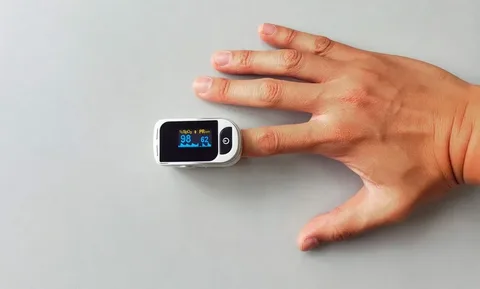إعلان مُمول
Monitoring Vitals Remotely Role of Pulse Oximeters in Healthcare

A pulse oximeter is a small, portable device that monitors the amount of oxygen in a patient's blood. It works non-invasively by shining a light through the skin and measuring how much light is absorbed by arterial blood. Oxygenated hemoglobin absorbs less infrared light than deoxygenated hemoglobin, allowing the pulse oximeter to calculate oximetry readings. Readings are typically reported as a percentage of oxygen saturation within the blood (SpO2). Pulse oximetry is a simple, painless, and reliable method for monitoring a patient's oxygen saturation levels and pulse rate.
Working Mechanism
Inside the pulse oximeter is a light-emitting diode (LED) light source and a photodetector. LEDs emit red and infrared light that passes through thin tissue such as a finger, earlobe, or toe. The photodetector on the other side of the tissue measures the amount of each light wavelength after absorption. Modern pulse oximeters contain microprocessors that analyze the absorbance and transit time of the two wavelengths of light through blood vessels to calculate functional oxygen saturation with each pulse. This non-invasive monitoring technique provides continuous SpO2 and pulse rate measurements in real-time.
Applications in Healthcare Settings
Pulse Oximeter find widespread use in many areas of healthcare due to their effectiveness in monitoring oxygen delivery to tissues and organs remotely. In hospitals, they are commonly used in emergency rooms, operating rooms, and intensive care units to alert clinicians of hypoxemia early on. Pulse oximetry is valuable for tracking patients on supplemental oxygen or ventilators. It is also used during procedures like colonoscopies that involve sedation when respiratory depression is a risk. In home settings, pulse oximeters allow monitoring chronic lung conditions and post-surgical recovery remotely to catch issues before they become critical. With the growth of telemedicine, pulse oximeters are enabling remote patient monitoring and virtual appointments.
Advantages over Alternative Monitoring Methods
While arterial blood gas (ABG) analysis provides a direct measure of oxygenation, it requires an invasive blood draw. Capnography requires additional nasal or oral cannulas and monitoring equipment. Compared to these methods, pulse oximetry offers several advantages - it provides continuous, non-invasive readings; requires simple finger or earlobe placement; has faster response times; and allows ambulatory monitoring. This has made pulse oximetry the standard of care for basic oxygen saturation and pulse rate monitoring globally. Advancements are expanding its capabilities - pulse CO-oximetry measures carboxyhemoglobin levels, while new sensors are enabling readings through motion and low perfusion conditions.
Technology Advancements Boosting Healthcare Access
Technological developments are enhancing pulse oximetry’s value proposition. Integrating the technology into wireless, multiparameter patient monitors expands monitoring capabilities from general wards to the home. Cloud connectivity enables remote transmission of readings to clinics. Low-cost, portable designs make pulse oximetry affordable and accessible even in resource-limited regions. Advanced algorithms improve accuracy in conditions like neonatal and low oxygen states. Newer finger, wrist-worn, and patch sensors improve compliance. Integration into smartphones and smartwatches is creating true pervasive monitoring solutions. These factors are fueling increased adoption across both hospital and remote patient monitoring markets globally. The future pipeline includes sensor innovations like tissue oxide profiling and non-contact photoplethysmography to revolutionize sensing form factors.
Market Outlook
According to industry reports, the global pulse oximetry market size was valued at USD 1.1 billion in 2019 and is expected to expand at a compound annual growth rate (CAGR) of 7.4% from 2020 to 2027. Some of the key factors driving market growth include the COVID-19 pandemic boosting demand, growing incidence of chronic lung diseases like COPD, technological advancements, increasing acceptance of home healthcare, development of portable/wearable oximeters, and expanding applications in anesthesia, surgery, and emergency care settings. Asia Pacific is projected to be the fastest-growing regional market due to rapidly developing healthcare infrastructure and rising medical tourism in countries like India and China. With continuous developments in sensing and connectivity technologies, pulse oximetry will remain integral to remote patient monitoring and overall healthcare access globally in the coming decade.
Get more insights on Pulse Oximeter
About Author:
Ravina Pandya, Content Writer, has a strong foothold in the market research industry. She specializes in writing well-researched articles from different industries, including food and beverages, information and technology, healthcare, chemical and materials, etc. (https://www.linkedin.com/in/ravina-pandya-1a3984191)



